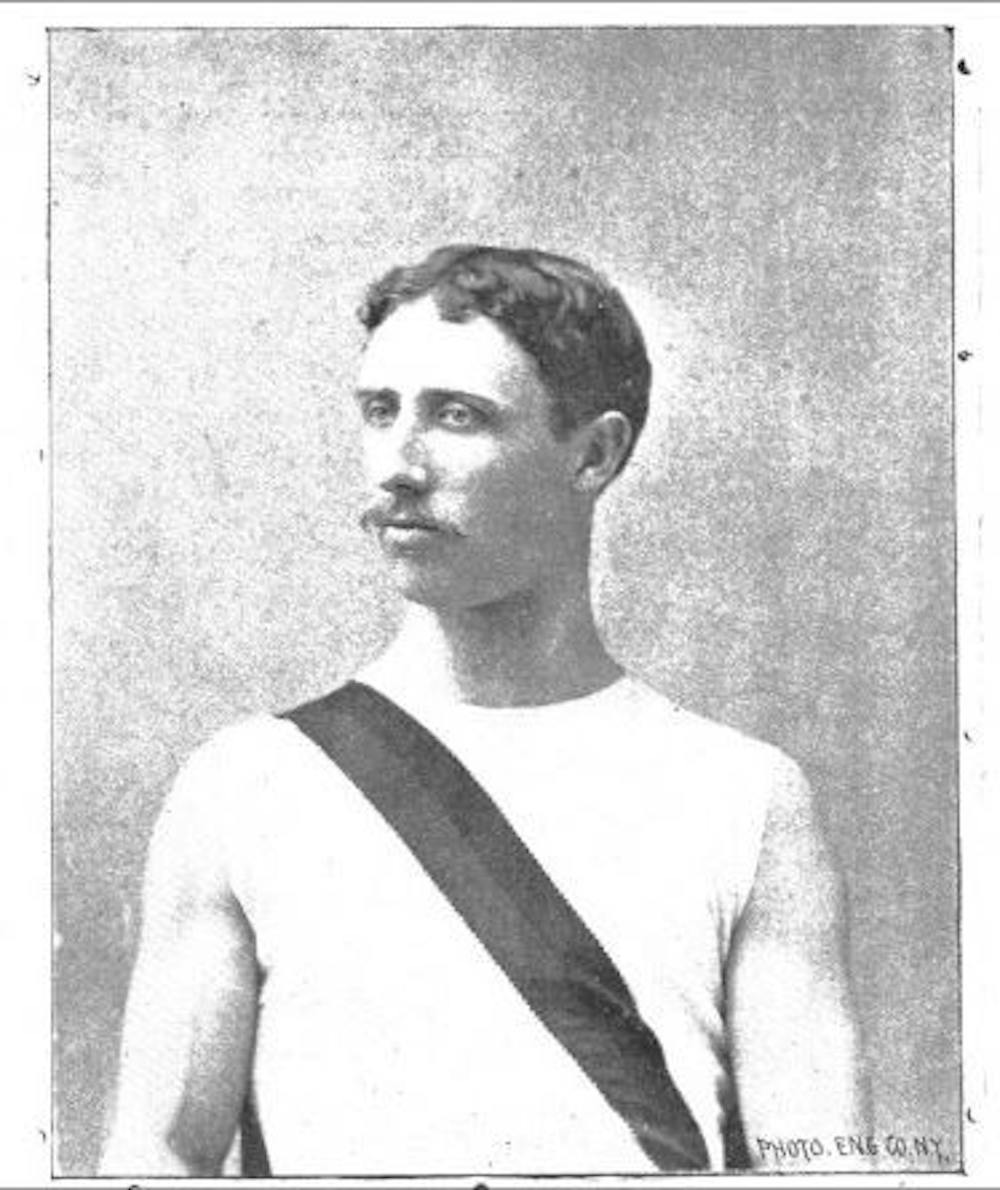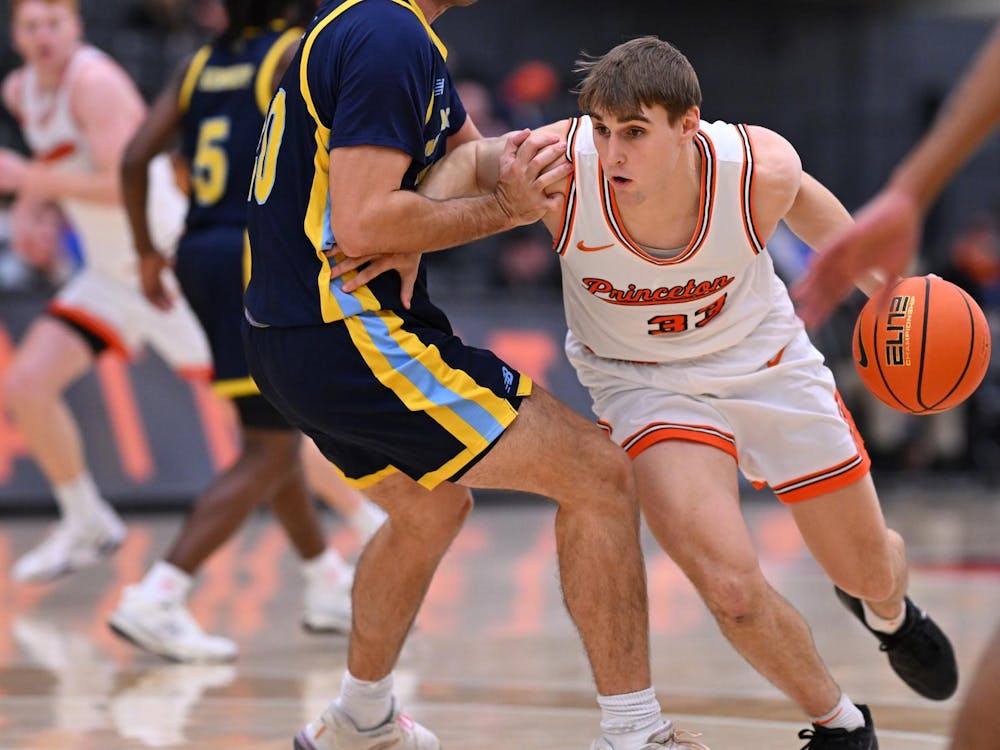University students and alumni began competing in the Olympics from the very first modern Games in 1896. From the late nineteenth century to the 1960s, while University Olympians represented the United States in a variety of sports, the majority competed in track and field events.
1896: The first Ivy Olympians
The 1896 Games in Athens had 241 competitors representing 14 nations, including the United States. The entire American team at these Games was made of twelve men from the Ivy League, according to the Ivy Leaguewebsite.
Of the twelve men, seven were from Harvard College, four from the University, and one from Columbia University. With the exception of two brothers from Harvard, the entire team travelled together to Greece on a ship.
All four University Olympians were from the Class of 1897 and Robert Garrett, Jr.’97 paid for the journey to Greece for Herbert Jamison '97, Francis Lane '97 and Albert Tyler‘97. All four had top-three finishes in their respective events.
Lane is considered to be the first American to compete in the Games after he won the 100 meter event heats at the Games in 12.2 seconds, according to his biography onSports Reference. Lane ran the final 100-meter race in12.6 seconds, earning him a third place finish at the Games. After graduating from the University, Lane went to medical school at Washington University in St. Louis, and eventually became head of the ophthalmology department atRush Medical College and the Presbyterian and Illinois Central Hospitals.
Lane’s cousin Tyler, who earned a second place finish in pole vault at the Games, also lettered in track, football and baseball at the University according to hisbiography on Sports Reference. Tyler went on to become a school teacher and a well-known football official.
Jamison chose to run the 400-meter race after he learnt that his favorite event, the 200-meter race, was not being run at the Games, according to his biography onSports Reference. He was ten meters behind Harvard’s Thomas Burke when the latter crossed the finish line, giving the former a second place finish at the race. Jamison went on to work in his family business, which manufacturedagricultural implements, for seven years until he founded his own insurance agency in his native Peoria, Ill., where he worked until his death in 1938.

Garrett competed in shot put, discus, high jump and long jump. He was awarded a silver medal, olive branch and diploma for finishing first in shot put; and a bronze medal, crown of laurel, and diploma for finishing second in high jump and long jump, right behind Harvard’s James Connolly.
For the discus event, Garrett had practiced with a discus he had built based on history books about the ancient Greek Games. However, when Garrett arrived at the Games, he found that the actual disc was much lighter than the one he had practiced with. According to his papers at the University’s Mudd Manuscript Library, Garrett initially threw his disc using techniques borrowed from hammer throw – he seized the disc in his right hand, swung himself round and round and then let go of the disc.
For his first two throws, the disc turned over repeatedly instead of sailing parallel to the ground and narrowly missed several members of the mocking Greek audience. Garrett then let out a large grunt and threw the disc again. Due to the “tremendous force” that, he wrote, went into the last throw, he beat the favored Greeks by 7.5 inches for a first place finish."All were stupefied. The Greeks had been defeated at their own classic exercise. They were overwhelmed by the superior skill and daring of the Americans, to whom they ascribed a supernatural invincibility enabling them to dispense with training and to win at games which they had never before seen," American spectator Burton Holmes wrote, according to Garrett.Garrett earned a total of four medals at the Games. He then competed in the 1900 Games in Paris before becoming a banker, financier and Trustee of the University.

1900: But it’sSunday
John Cregan and Frank Jarvis, both of the Class of 1900, competed along with Garrett at the 1900 Games.Garrett competed in shot put, discuss, standing triple jump and tug of war, according toHerman’s Full Olympiansand the book “The 1900 Olympic Games.” Garrett was forced to withdraw from the tug of war event after three of his six team mates could not attend it due to a scheduling conflict with the hammer throw final. Garrett also scored a third place finish at the standing triple jump event. In the discus event, however, he was unable to make a legal mark after all his discus throws hit the trees.Garrett refused to compete in the final shot put event because it took place on aSunday. However, his throw during the qualifier sufficed to award him third place. Cregan too withdrew from the 1500-meter race, for which he was the favorite for gold, because it fell on aSunday, according to hisbiographyon Sports Reference. Cregan placed second in the 800-meter men’s race, when he finished three yards behind first place winner, Alfred Tysoe.Fellow American Arthur Duffey was the favorite to win Jarvis’ 100-meter race, according to Jarvis’biographyon Sports Reference. For the entire first half of the race, Jarvis and Duffey ran head to head until Duffey pulled a muscle, fell and retired the race. Jarvis then won first place in the 100-meter race, though he did not acquire top positions in triple jump or standing triple jump.
1904 – 1912: That One Tiger
John DeWitt, Class of 1904, was the only Olympian from the University at the 1904 Games in St. Louis. The former captain of the University’s football teamplaced secondin hammer throw at the Games.
J.L. Eisele, Class of 1906, was the only Olympian from the University at the 1908 Games in London. According to a 1908articlein the San Francisco Call, Eisele ran three of the hardest races the week before he unexpectedly made it to the final steeplechase. Eisele ran the final with an injured foot against the British, who emerged victorious in the end.
“Just a little more stamina and a little more luck and Eisele would have captured some of the distance events for America,” the Call reported.
The 1912 Games in Stockholm, the first to host athletes from all eight Ivies, had Rupert Thomas from the Class of 1913 as the only Olympian from the University. At the Games, Thomas ran the 100-meter race, butwas eliminated in the semi-final.
1920–1936: The Interwar Period
The 1916 Berlin Games were cancelled due to World War I. The 1920 Games were awarded to the Belgian capital of Antwerp in a showing of compassion, though the former Central Powers of Germany, Austria, Hungary, Bulgaria and Turkey were not permitted to participate.
Karl Frederick, Class of 1903, won three medals at the 1920 Games in free pistol, free pistol team and rapid fire pistol team.Frederick was a practicing lawyer in New York City at the time of the Games andwent onto become president of the National Rifle Association.Henry Breckenridge, Class of 1907, was a member of the fencing team at the 1920 and 1928 Games and was captain of the latter. During World War I, Breckenridge had served as abattalioncommander and as the United States Assistant Secretary of War. At the 1920 Games, Breckenridge competed in both the foil and epee events. He won the deciding bout against Great Britain in the foil event, earning the United States a silver medal.
Ralph Hills '25 competed in shot put the 1920 and 1924 Games, winning a bronze medal in the latter. Hills then went on to be a physician and served overseas during World War II, after which he was discharged with the rank of lieutenant colonel.William Stevenson '22 ran the last leg of the 4x400-meter relay to lead the United States team to gold at the 1924 Games in Paris. He and his wife then organized and administered American Red Cross operations in Great Britain, North Africa, Sicily and Italy, for whichthey were awarded the Bronze Starformeritorious achievement in support of military operations.Ben Hedges ’30, whowon 13 Battle Stars and received a Presidential Unit Citation for his work in the Pacific as an air combat intelligence officer, won a silver medal in high jump at the 1928 Games in Amsterdam. The next track and field medal from a University Olympian came 64 years later, at the 1992 Games in Barcelona.At the 1932 Games in Los Angeles, four of the six University Olympians competed on the U.S. field hockey team to win a bronze medal. Tracy Jaeckel ’28 added another bronze medal to the tally from the epee team.
Five of the seven alumni who competed in the 1936 Games in Berlin competed on the U.S. field hockey team, which had a seventh place finish. Al Van de Weghe ’40, a sixteen year old high school student at the time, won a silver medal at the 100-meter backstroke in the 1936 Games. Van de Weghe then wonthree consecutive NCAA championshipsin the 150-yard backstroke when he swam with University’s swimming and diving team. He did notlose a single college dual meet over his entire college career.
Van de Weghe remainedas a member of the USA National and honorary USA Olympic team during the 1940 and 1944 Games, which were cancelled due to World War II.
Next in The Olympics Series: 1940s to 1960s








